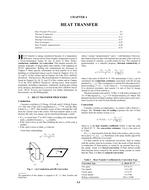Heat transfer is energy transferred because of a temperature difference. Energy moves from a higher-temperature region to a lower-temperature region by one or more of three modes: conduction, radiation, and convection. This chapter presents elementary principles of single-phase heat transfer, with emphasis on HVAC applications. Boiling and condensation are discussed in Chapter 5. More specific information on heat transfer to or from buildings or refrigerated spaces can be found in Chapters 14 to 19, 23, and 27 of this volume and in Chapter 24 of the 2014 ASHRAE Handbook–Refrigeration. Physical properties of substances can be found in Chapters 26, 28, 32, and 33 of this volume and in Chapter 19 of the 2014 ASHRAE Handbook–Refrigeration. Heat transfer equipment, including evaporators, condensers, heating and cooling coils, furnaces, and radiators, is covered in the 2016 ASHRAE Handbook–HVAC Systems and Equipment. For further information on heat transfer, see the Bibliography.
Heat Transfer Processes
Thermal Conduction
Thermal Radiation
Thermal Convection
Heat Exchangers
Heat Transfer Augmentation
Symbols
ISBN: 978-1-939200-57-0 (for I-P versions of chapters)
ISSN: 1523-7222 (for I-P versions of chapters)
Citation: 2017 ASHRAE Handbook — Fundamentals: Chapter 4, Heat Transfer
Product Details
- Published:
- 2017
- ISBN(s):
- 9781939200570
- Number of Pages:
- 36
- Units of Measure:
- I-P
- File Size:
- 1 file , 4.3 MB
- Product Code(s):
- D-F042017IP
